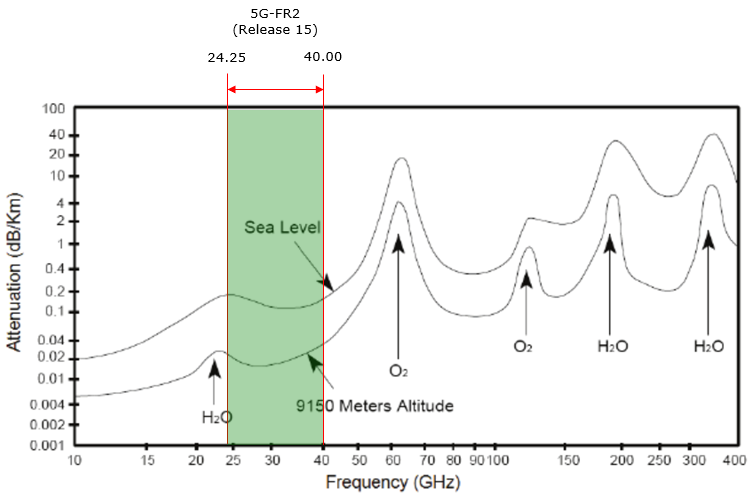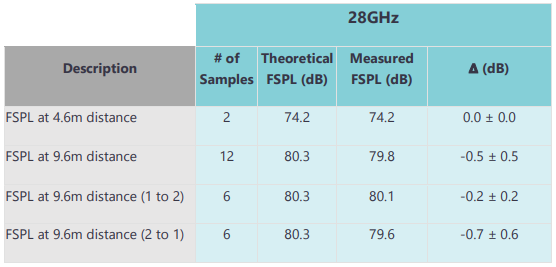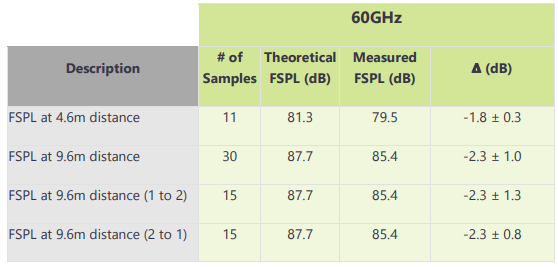|
RF |
||
|
Millimeter Wave
As the name implies, millimeter wave is a electro magnetic wave with the wavelength falling into the scale of millimeter. Usually it refers to the wavelength of 10~1 mm. If you convert the wavelength into frequency : 1 mm corresponds to 300 Ghz and 10 mm corresponds to 30 Ghz. However, like many other concepts, the exact range of 'Millimeter Wave' is not clearly defined. Somebody call it millimeter wave if it is higher than 20 Ghz and some other person has other range definition.
Well known spectrums in mmWave
Within the spectrum of millimeter wave, there are several commonly used bands. Some of these commonly used bands are :
Oxygen Aattenuation versus Frequency
Which spectrum is used for 5G ?
Which of the spectrum listed above is used for 5G ? As you see in this table, Ka band is used for the initial deployment of 5G and V band would be the next target (future release) for 5G.
According to Ref [3], the baseline pathloss between Transmitter and Reciever is as follows. You would notice that the pathloss gets over 80 dB at 28 Ghz and over 88 dB just 10 m away from transmitter. The loss difference between 5m and 10 m is around 6dB. For the detailed description on test condition and beam characteristics, refer to Ref [3]. Compare this result with what is described in this page.
One of the strongest passimisim about utilizing mmWave in wirelss communication has been poor penetration (high transmission loss) for most of materials that surrounds us. In this section, I will consolidate experimental data showing the penetration characteristics of mmWave. As you may easily guess, the penetration loss would be different on the characteristics of the material through which the mmWave passes and the thickness of the material.
According to Ref [3], the penetration loss measured for Plywood is around 5 dB at 28 Ghz and the loss difference between 12 and 18 mm is just about 0.5 dB. The loss gets lower with incident angle of the wave. It is around 2 dB lower at the incident angle 45 comparing to the incident angle 0.
According to Ref [3], the penetration loss measured for Plywood is a little less than I expected. At 28Ghz, the loss is around 1dB with 1 layer 12 mm thickness and 2.5 dB with 4 layer 48 mm thickness. At 60Ghz, the loss is around 1.5dB with 1 layer 12 mm thickness and 5.2 dB with 4 layer 48 mm thickness.
There are so many variants of glass and the penetration loss also varies a lot with the type of the glass.
According to Ref [3], the penetration loss measured for what the paper calls Glass #1 is around 27 dB at 28Ghz and 33 dB at 60 Ghz (NOTE : Glass #1 is described as low-emissivity double-pane window glass that is representative of glass commonly used in window interfacing between interiors and the outside). The loss for what the paper calls Glass #2 is just around 3dB at both 28Ghz and 30Ghz. (NOTE : Glass #2 seems to be a regular glasses).
The penetration loss varies depending on the density of the foliage and which part of the foliage the wave get through (i.e, the distance between the center of the foliage and the center of wave propagation).
According to Ref [3], I don't see such a huge difference in terms of the loss among different densities but see wide differences depending on which part of the foliage the wave pass through. When the wave pass through the center of the foliage the 20 ~ 30 dB.
Reference :
[1] Millimeter Waves Will Expand The Wireless Future. I strongly recommend you to read the article, it will give you very practical insight on Millimiter wave. [2] TWS 2015: Millimeter Wave for 5G [3] Analysis of 28GHz and 60GHz Channel Measurements in an Indoor Environment [4] 28-GHz Indoor Channel Measurements and Analysis of Propagation Characteristics [5] Indoor mm-Wave Channel Measurements: Comparative Study of 2.9 GHz and 29 GHz [6] Outdoor-to-Indoor Channel Measurement and Coverage Analysis for 5G Typical Spectrums [8] Outdoor to Indoor Penetration Loss at 28 GHz for Fixed Wireless Access [9] Outdoor-to-Indoor Channel Measurement and Coverage Analysis for 5G Typical Spectrums [11] Beamforming Simulations for 5G mmWave and FD MIMO (YouTube)
|
||


